Management Accounting Report for Whale Water Systems Analysis
VerifiedAdded on 2021/02/19
|18
|4869
|620
Report
AI Summary
This report provides a comprehensive overview of management accounting, focusing on its key functions, different types of systems, and reporting methods within the context of Whale Water Systems, a UK-based medium-sized enterprise. The report delves into the computation of costs using marginal and absorption costing techniques, presenting detailed cost cards and income statements for Primark Furniture PLC. It also explores the advantages and disadvantages of various planning tools used for budgetary control and examines how organizations adapt their management accounting systems to address financial challenges. The report covers essential topics such as financial accounting systems, cost accounting systems, and tax accounting systems, offering insights into their roles in decision-making and financial management. It includes an analysis of trading and profit and loss accounts, balance sheets, and cash flow statements, along with an examination of inventory management and job-costing systems. Overall, the report provides a thorough understanding of management accounting principles and their practical application.
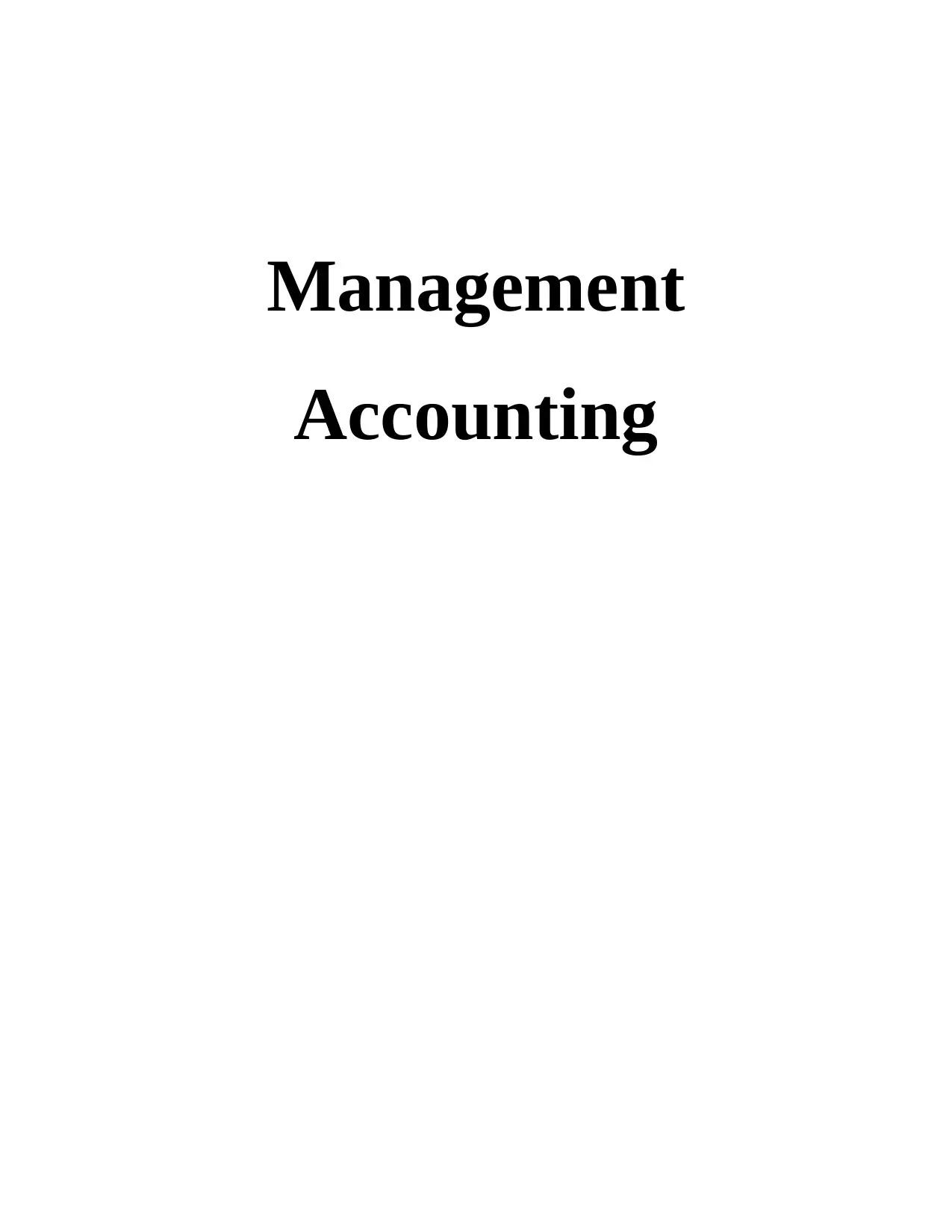
Management
Accounting
Accounting
Paraphrase This Document
Need a fresh take? Get an instant paraphrase of this document with our AI Paraphraser
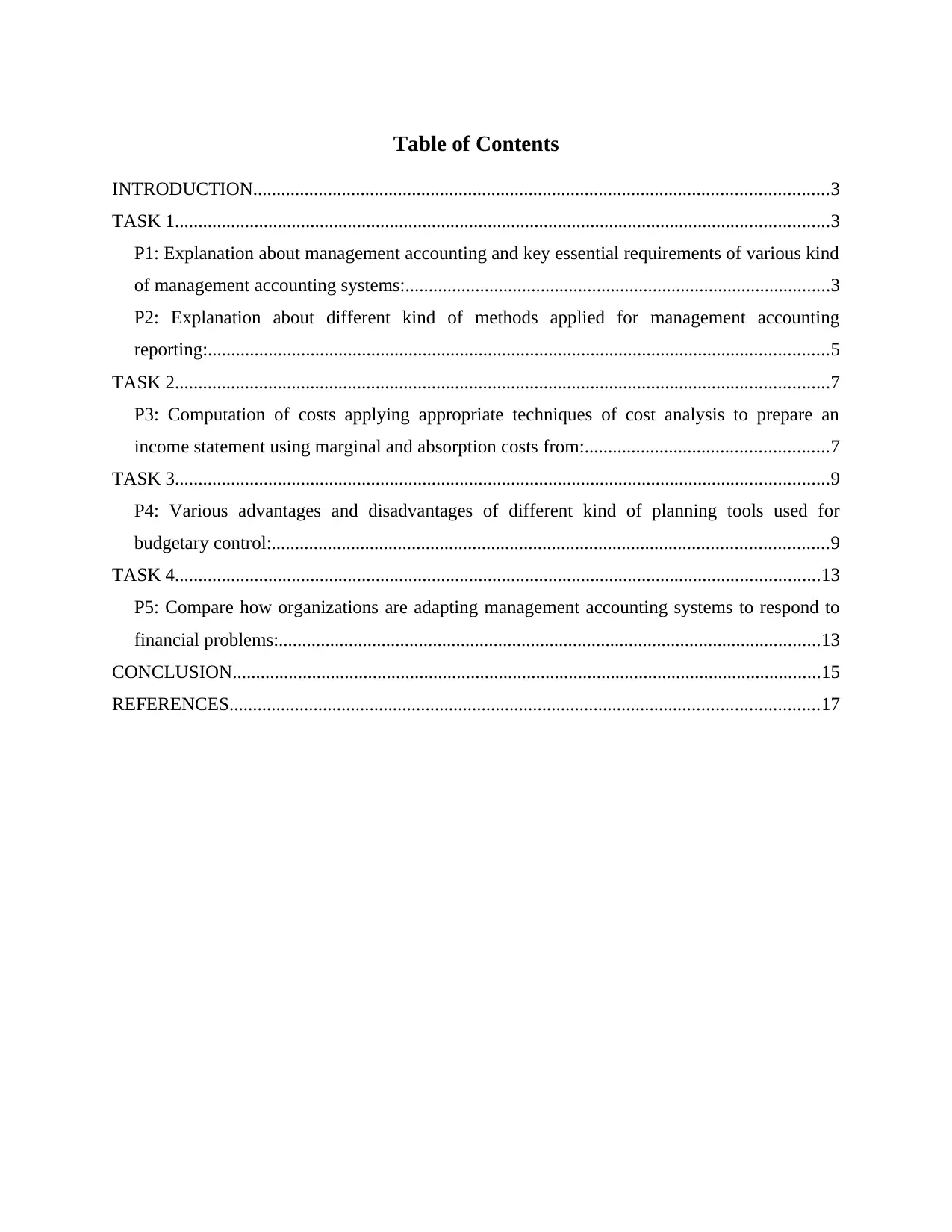
Table of Contents
INTRODUCTION...........................................................................................................................3
TASK 1............................................................................................................................................3
P1: Explanation about management accounting and key essential requirements of various kind
of management accounting systems:...........................................................................................3
P2: Explanation about different kind of methods applied for management accounting
reporting:.....................................................................................................................................5
TASK 2............................................................................................................................................7
P3: Computation of costs applying appropriate techniques of cost analysis to prepare an
income statement using marginal and absorption costs from:....................................................7
TASK 3............................................................................................................................................9
P4: Various advantages and disadvantages of different kind of planning tools used for
budgetary control:.......................................................................................................................9
TASK 4..........................................................................................................................................13
P5: Compare how organizations are adapting management accounting systems to respond to
financial problems:....................................................................................................................13
CONCLUSION..............................................................................................................................15
REFERENCES..............................................................................................................................17
INTRODUCTION...........................................................................................................................3
TASK 1............................................................................................................................................3
P1: Explanation about management accounting and key essential requirements of various kind
of management accounting systems:...........................................................................................3
P2: Explanation about different kind of methods applied for management accounting
reporting:.....................................................................................................................................5
TASK 2............................................................................................................................................7
P3: Computation of costs applying appropriate techniques of cost analysis to prepare an
income statement using marginal and absorption costs from:....................................................7
TASK 3............................................................................................................................................9
P4: Various advantages and disadvantages of different kind of planning tools used for
budgetary control:.......................................................................................................................9
TASK 4..........................................................................................................................................13
P5: Compare how organizations are adapting management accounting systems to respond to
financial problems:....................................................................................................................13
CONCLUSION..............................................................................................................................15
REFERENCES..............................................................................................................................17
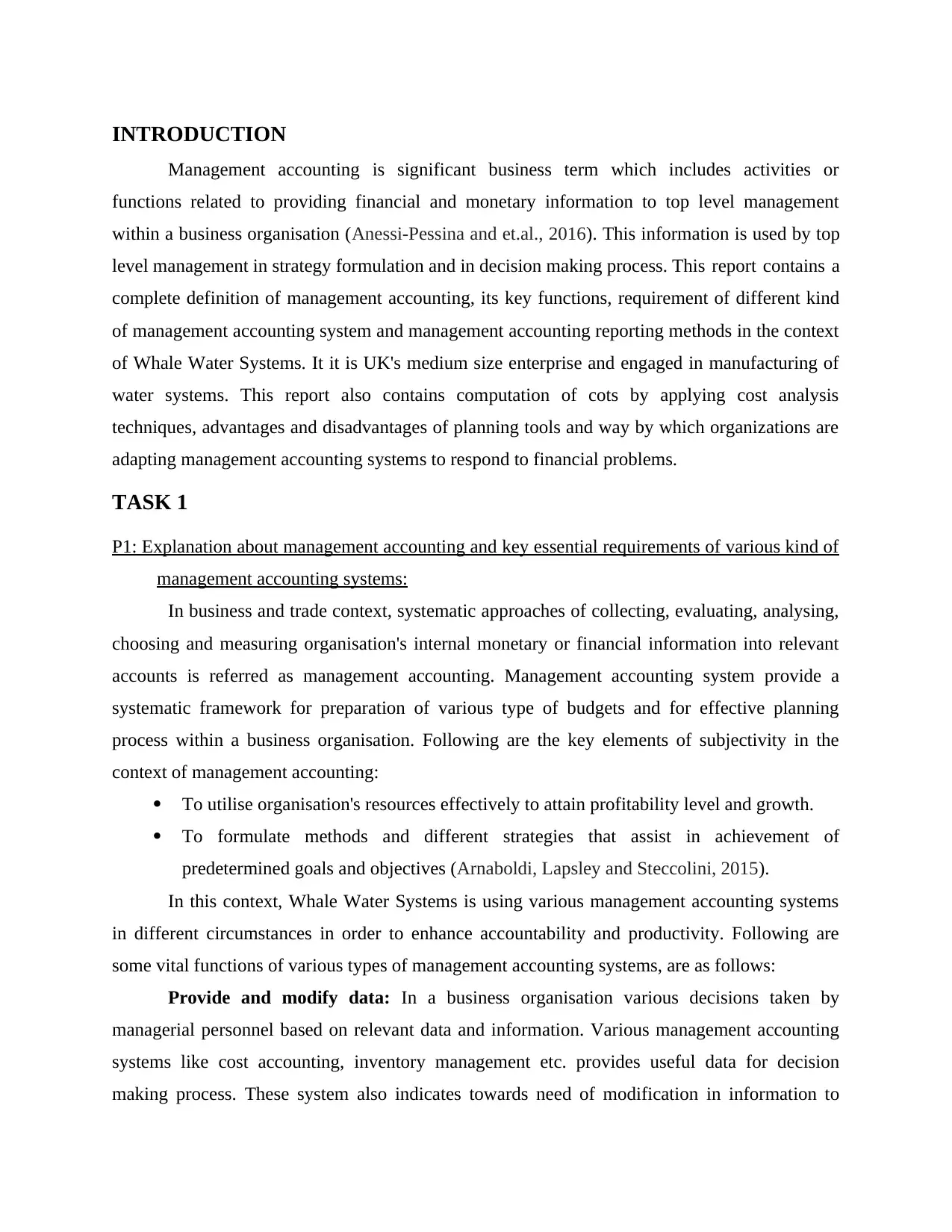
INTRODUCTION
Management accounting is significant business term which includes activities or
functions related to providing financial and monetary information to top level management
within a business organisation (Anessi-Pessina and et.al., 2016). This information is used by top
level management in strategy formulation and in decision making process. This report contains a
complete definition of management accounting, its key functions, requirement of different kind
of management accounting system and management accounting reporting methods in the context
of Whale Water Systems. It it is UK's medium size enterprise and engaged in manufacturing of
water systems. This report also contains computation of cots by applying cost analysis
techniques, advantages and disadvantages of planning tools and way by which organizations are
adapting management accounting systems to respond to financial problems.
TASK 1
P1: Explanation about management accounting and key essential requirements of various kind of
management accounting systems:
In business and trade context, systematic approaches of collecting, evaluating, analysing,
choosing and measuring organisation's internal monetary or financial information into relevant
accounts is referred as management accounting. Management accounting system provide a
systematic framework for preparation of various type of budgets and for effective planning
process within a business organisation. Following are the key elements of subjectivity in the
context of management accounting:
To utilise organisation's resources effectively to attain profitability level and growth.
To formulate methods and different strategies that assist in achievement of
predetermined goals and objectives (Arnaboldi, Lapsley and Steccolini, 2015).
In this context, Whale Water Systems is using various management accounting systems
in different circumstances in order to enhance accountability and productivity. Following are
some vital functions of various types of management accounting systems, are as follows:
Provide and modify data: In a business organisation various decisions taken by
managerial personnel based on relevant data and information. Various management accounting
systems like cost accounting, inventory management etc. provides useful data for decision
making process. These system also indicates towards need of modification in information to
Management accounting is significant business term which includes activities or
functions related to providing financial and monetary information to top level management
within a business organisation (Anessi-Pessina and et.al., 2016). This information is used by top
level management in strategy formulation and in decision making process. This report contains a
complete definition of management accounting, its key functions, requirement of different kind
of management accounting system and management accounting reporting methods in the context
of Whale Water Systems. It it is UK's medium size enterprise and engaged in manufacturing of
water systems. This report also contains computation of cots by applying cost analysis
techniques, advantages and disadvantages of planning tools and way by which organizations are
adapting management accounting systems to respond to financial problems.
TASK 1
P1: Explanation about management accounting and key essential requirements of various kind of
management accounting systems:
In business and trade context, systematic approaches of collecting, evaluating, analysing,
choosing and measuring organisation's internal monetary or financial information into relevant
accounts is referred as management accounting. Management accounting system provide a
systematic framework for preparation of various type of budgets and for effective planning
process within a business organisation. Following are the key elements of subjectivity in the
context of management accounting:
To utilise organisation's resources effectively to attain profitability level and growth.
To formulate methods and different strategies that assist in achievement of
predetermined goals and objectives (Arnaboldi, Lapsley and Steccolini, 2015).
In this context, Whale Water Systems is using various management accounting systems
in different circumstances in order to enhance accountability and productivity. Following are
some vital functions of various types of management accounting systems, are as follows:
Provide and modify data: In a business organisation various decisions taken by
managerial personnel based on relevant data and information. Various management accounting
systems like cost accounting, inventory management etc. provides useful data for decision
making process. These system also indicates towards need of modification in information to
⊘ This is a preview!⊘
Do you want full access?
Subscribe today to unlock all pages.

Trusted by 1+ million students worldwide
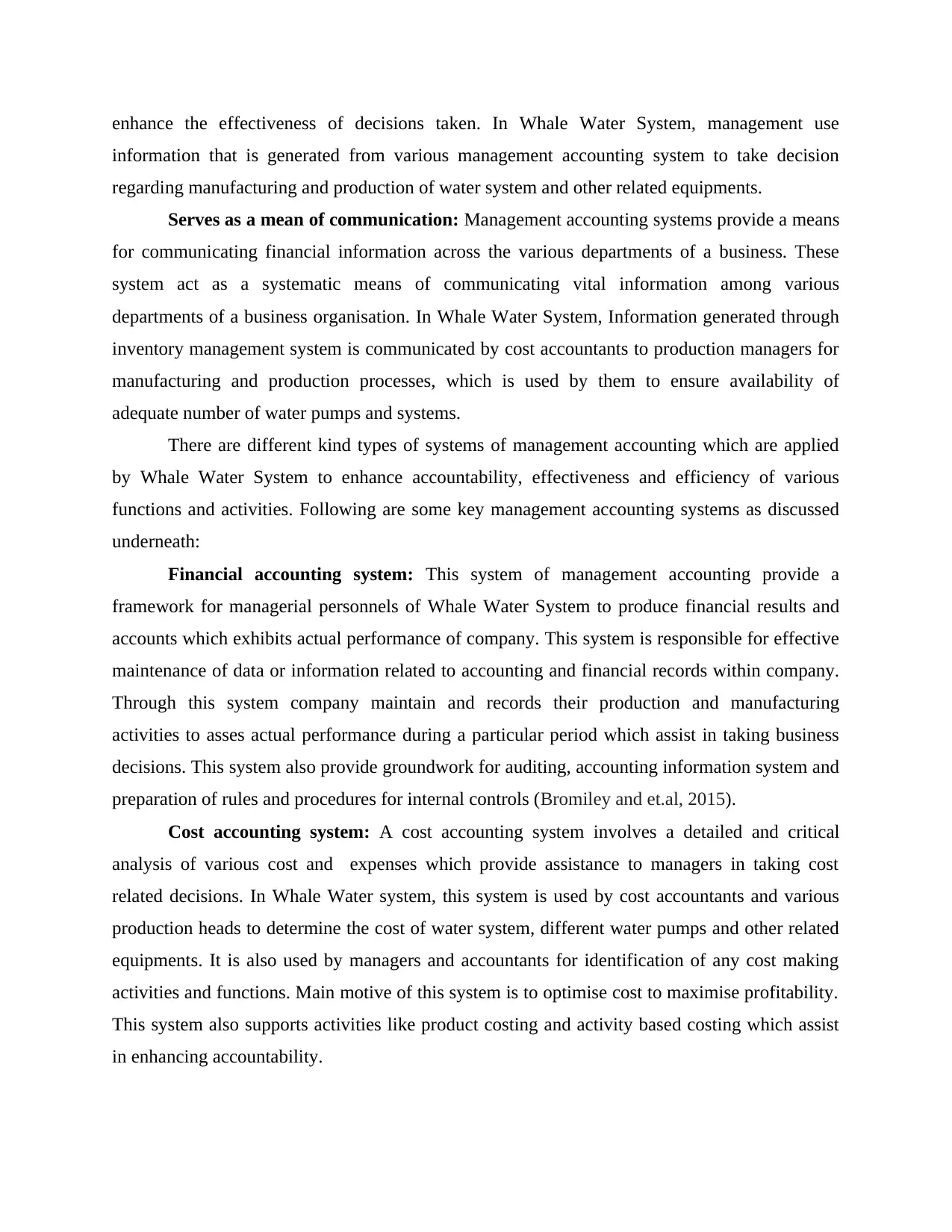
enhance the effectiveness of decisions taken. In Whale Water System, management use
information that is generated from various management accounting system to take decision
regarding manufacturing and production of water system and other related equipments.
Serves as a mean of communication: Management accounting systems provide a means
for communicating financial information across the various departments of a business. These
system act as a systematic means of communicating vital information among various
departments of a business organisation. In Whale Water System, Information generated through
inventory management system is communicated by cost accountants to production managers for
manufacturing and production processes, which is used by them to ensure availability of
adequate number of water pumps and systems.
There are different kind types of systems of management accounting which are applied
by Whale Water System to enhance accountability, effectiveness and efficiency of various
functions and activities. Following are some key management accounting systems as discussed
underneath:
Financial accounting system: This system of management accounting provide a
framework for managerial personnels of Whale Water System to produce financial results and
accounts which exhibits actual performance of company. This system is responsible for effective
maintenance of data or information related to accounting and financial records within company.
Through this system company maintain and records their production and manufacturing
activities to asses actual performance during a particular period which assist in taking business
decisions. This system also provide groundwork for auditing, accounting information system and
preparation of rules and procedures for internal controls (Bromiley and et.al, 2015).
Cost accounting system: A cost accounting system involves a detailed and critical
analysis of various cost and expenses which provide assistance to managers in taking cost
related decisions. In Whale Water system, this system is used by cost accountants and various
production heads to determine the cost of water system, different water pumps and other related
equipments. It is also used by managers and accountants for identification of any cost making
activities and functions. Main motive of this system is to optimise cost to maximise profitability.
This system also supports activities like product costing and activity based costing which assist
in enhancing accountability.
information that is generated from various management accounting system to take decision
regarding manufacturing and production of water system and other related equipments.
Serves as a mean of communication: Management accounting systems provide a means
for communicating financial information across the various departments of a business. These
system act as a systematic means of communicating vital information among various
departments of a business organisation. In Whale Water System, Information generated through
inventory management system is communicated by cost accountants to production managers for
manufacturing and production processes, which is used by them to ensure availability of
adequate number of water pumps and systems.
There are different kind types of systems of management accounting which are applied
by Whale Water System to enhance accountability, effectiveness and efficiency of various
functions and activities. Following are some key management accounting systems as discussed
underneath:
Financial accounting system: This system of management accounting provide a
framework for managerial personnels of Whale Water System to produce financial results and
accounts which exhibits actual performance of company. This system is responsible for effective
maintenance of data or information related to accounting and financial records within company.
Through this system company maintain and records their production and manufacturing
activities to asses actual performance during a particular period which assist in taking business
decisions. This system also provide groundwork for auditing, accounting information system and
preparation of rules and procedures for internal controls (Bromiley and et.al, 2015).
Cost accounting system: A cost accounting system involves a detailed and critical
analysis of various cost and expenses which provide assistance to managers in taking cost
related decisions. In Whale Water system, this system is used by cost accountants and various
production heads to determine the cost of water system, different water pumps and other related
equipments. It is also used by managers and accountants for identification of any cost making
activities and functions. Main motive of this system is to optimise cost to maximise profitability.
This system also supports activities like product costing and activity based costing which assist
in enhancing accountability.
Paraphrase This Document
Need a fresh take? Get an instant paraphrase of this document with our AI Paraphraser
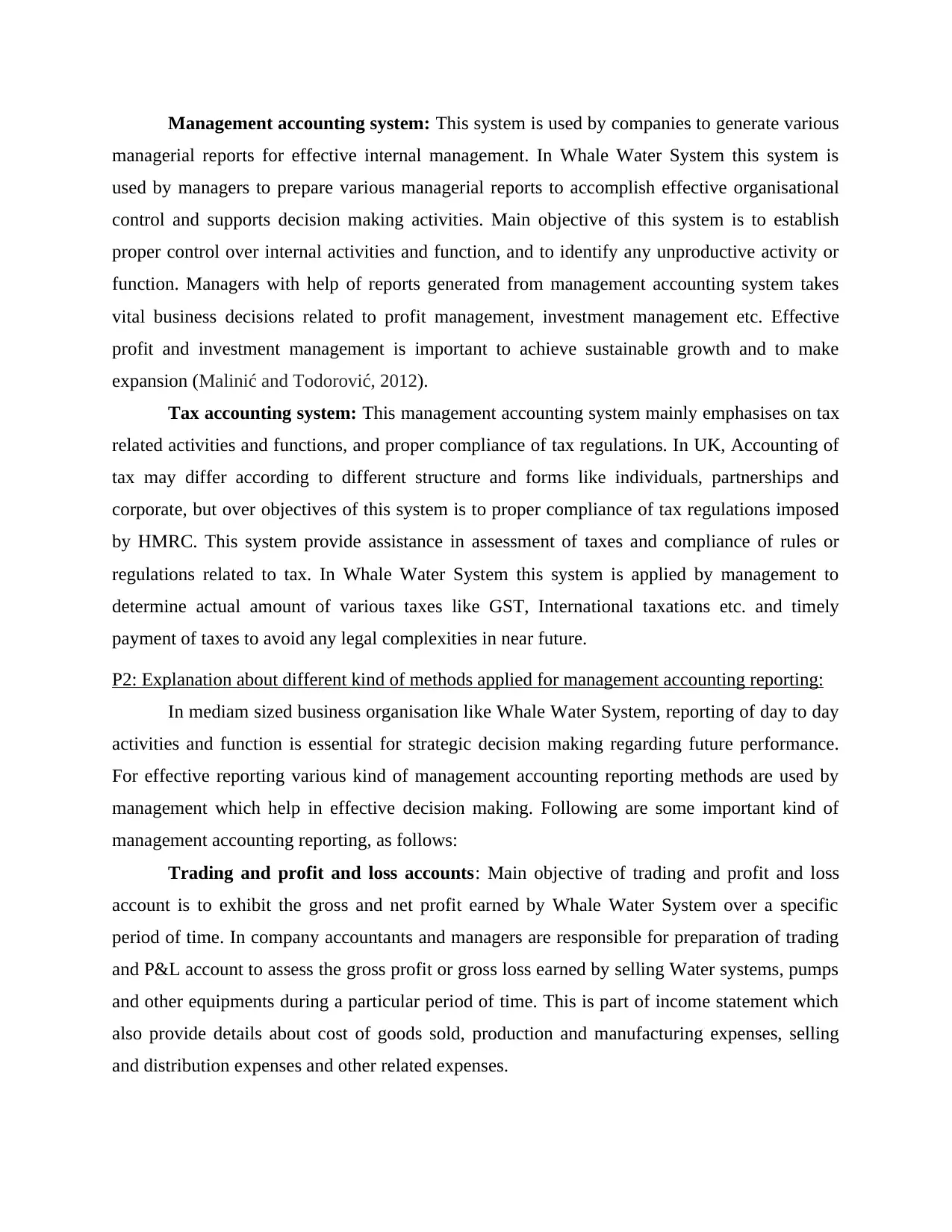
Management accounting system: This system is used by companies to generate various
managerial reports for effective internal management. In Whale Water System this system is
used by managers to prepare various managerial reports to accomplish effective organisational
control and supports decision making activities. Main objective of this system is to establish
proper control over internal activities and function, and to identify any unproductive activity or
function. Managers with help of reports generated from management accounting system takes
vital business decisions related to profit management, investment management etc. Effective
profit and investment management is important to achieve sustainable growth and to make
expansion (Malinić and Todorović, 2012).
Tax accounting system: This management accounting system mainly emphasises on tax
related activities and functions, and proper compliance of tax regulations. In UK, Accounting of
tax may differ according to different structure and forms like individuals, partnerships and
corporate, but over objectives of this system is to proper compliance of tax regulations imposed
by HMRC. This system provide assistance in assessment of taxes and compliance of rules or
regulations related to tax. In Whale Water System this system is applied by management to
determine actual amount of various taxes like GST, International taxations etc. and timely
payment of taxes to avoid any legal complexities in near future.
P2: Explanation about different kind of methods applied for management accounting reporting:
In mediam sized business organisation like Whale Water System, reporting of day to day
activities and function is essential for strategic decision making regarding future performance.
For effective reporting various kind of management accounting reporting methods are used by
management which help in effective decision making. Following are some important kind of
management accounting reporting, as follows:
Trading and profit and loss accounts: Main objective of trading and profit and loss
account is to exhibit the gross and net profit earned by Whale Water System over a specific
period of time. In company accountants and managers are responsible for preparation of trading
and P&L account to assess the gross profit or gross loss earned by selling Water systems, pumps
and other equipments during a particular period of time. This is part of income statement which
also provide details about cost of goods sold, production and manufacturing expenses, selling
and distribution expenses and other related expenses.
managerial reports for effective internal management. In Whale Water System this system is
used by managers to prepare various managerial reports to accomplish effective organisational
control and supports decision making activities. Main objective of this system is to establish
proper control over internal activities and function, and to identify any unproductive activity or
function. Managers with help of reports generated from management accounting system takes
vital business decisions related to profit management, investment management etc. Effective
profit and investment management is important to achieve sustainable growth and to make
expansion (Malinić and Todorović, 2012).
Tax accounting system: This management accounting system mainly emphasises on tax
related activities and functions, and proper compliance of tax regulations. In UK, Accounting of
tax may differ according to different structure and forms like individuals, partnerships and
corporate, but over objectives of this system is to proper compliance of tax regulations imposed
by HMRC. This system provide assistance in assessment of taxes and compliance of rules or
regulations related to tax. In Whale Water System this system is applied by management to
determine actual amount of various taxes like GST, International taxations etc. and timely
payment of taxes to avoid any legal complexities in near future.
P2: Explanation about different kind of methods applied for management accounting reporting:
In mediam sized business organisation like Whale Water System, reporting of day to day
activities and function is essential for strategic decision making regarding future performance.
For effective reporting various kind of management accounting reporting methods are used by
management which help in effective decision making. Following are some important kind of
management accounting reporting, as follows:
Trading and profit and loss accounts: Main objective of trading and profit and loss
account is to exhibit the gross and net profit earned by Whale Water System over a specific
period of time. In company accountants and managers are responsible for preparation of trading
and P&L account to assess the gross profit or gross loss earned by selling Water systems, pumps
and other equipments during a particular period of time. This is part of income statement which
also provide details about cost of goods sold, production and manufacturing expenses, selling
and distribution expenses and other related expenses.
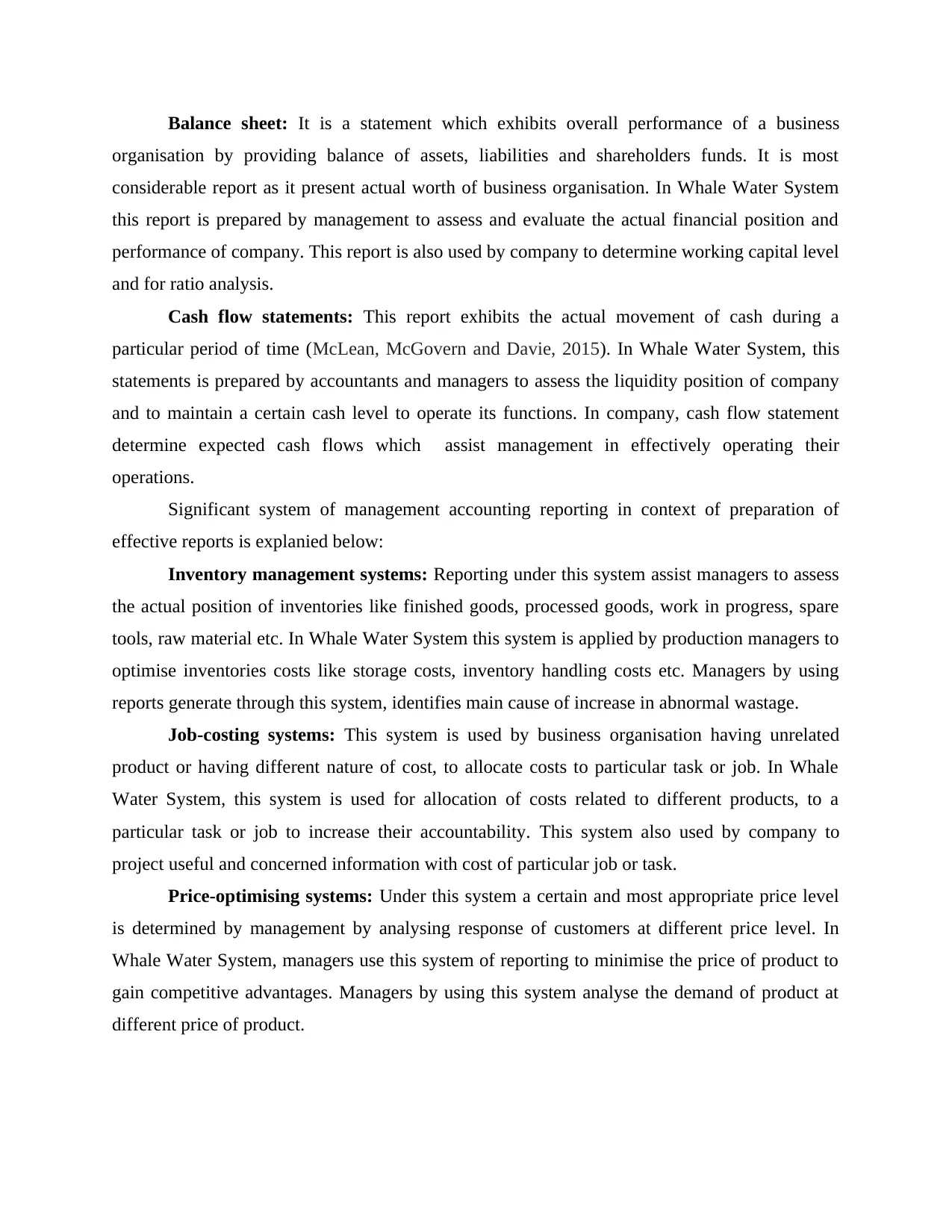
Balance sheet: It is a statement which exhibits overall performance of a business
organisation by providing balance of assets, liabilities and shareholders funds. It is most
considerable report as it present actual worth of business organisation. In Whale Water System
this report is prepared by management to assess and evaluate the actual financial position and
performance of company. This report is also used by company to determine working capital level
and for ratio analysis.
Cash flow statements: This report exhibits the actual movement of cash during a
particular period of time (McLean, McGovern and Davie, 2015). In Whale Water System, this
statements is prepared by accountants and managers to assess the liquidity position of company
and to maintain a certain cash level to operate its functions. In company, cash flow statement
determine expected cash flows which assist management in effectively operating their
operations.
Significant system of management accounting reporting in context of preparation of
effective reports is explanied below:
Inventory management systems: Reporting under this system assist managers to assess
the actual position of inventories like finished goods, processed goods, work in progress, spare
tools, raw material etc. In Whale Water System this system is applied by production managers to
optimise inventories costs like storage costs, inventory handling costs etc. Managers by using
reports generate through this system, identifies main cause of increase in abnormal wastage.
Job-costing systems: This system is used by business organisation having unrelated
product or having different nature of cost, to allocate costs to particular task or job. In Whale
Water System, this system is used for allocation of costs related to different products, to a
particular task or job to increase their accountability. This system also used by company to
project useful and concerned information with cost of particular job or task.
Price-optimising systems: Under this system a certain and most appropriate price level
is determined by management by analysing response of customers at different price level. In
Whale Water System, managers use this system of reporting to minimise the price of product to
gain competitive advantages. Managers by using this system analyse the demand of product at
different price of product.
organisation by providing balance of assets, liabilities and shareholders funds. It is most
considerable report as it present actual worth of business organisation. In Whale Water System
this report is prepared by management to assess and evaluate the actual financial position and
performance of company. This report is also used by company to determine working capital level
and for ratio analysis.
Cash flow statements: This report exhibits the actual movement of cash during a
particular period of time (McLean, McGovern and Davie, 2015). In Whale Water System, this
statements is prepared by accountants and managers to assess the liquidity position of company
and to maintain a certain cash level to operate its functions. In company, cash flow statement
determine expected cash flows which assist management in effectively operating their
operations.
Significant system of management accounting reporting in context of preparation of
effective reports is explanied below:
Inventory management systems: Reporting under this system assist managers to assess
the actual position of inventories like finished goods, processed goods, work in progress, spare
tools, raw material etc. In Whale Water System this system is applied by production managers to
optimise inventories costs like storage costs, inventory handling costs etc. Managers by using
reports generate through this system, identifies main cause of increase in abnormal wastage.
Job-costing systems: This system is used by business organisation having unrelated
product or having different nature of cost, to allocate costs to particular task or job. In Whale
Water System, this system is used for allocation of costs related to different products, to a
particular task or job to increase their accountability. This system also used by company to
project useful and concerned information with cost of particular job or task.
Price-optimising systems: Under this system a certain and most appropriate price level
is determined by management by analysing response of customers at different price level. In
Whale Water System, managers use this system of reporting to minimise the price of product to
gain competitive advantages. Managers by using this system analyse the demand of product at
different price of product.
⊘ This is a preview!⊘
Do you want full access?
Subscribe today to unlock all pages.

Trusted by 1+ million students worldwide
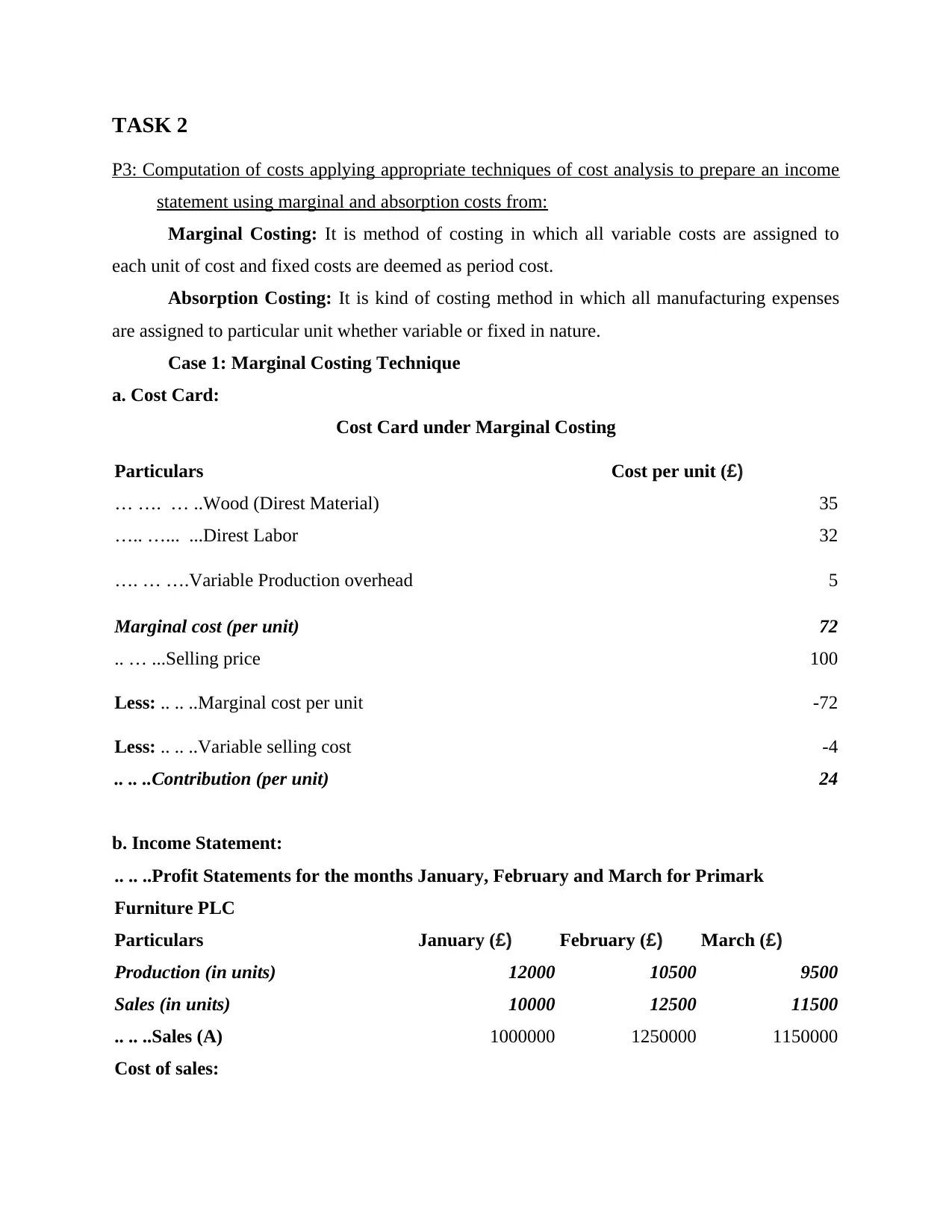
TASK 2
P3: Computation of costs applying appropriate techniques of cost analysis to prepare an income
statement using marginal and absorption costs from:
Marginal Costing: It is method of costing in which all variable costs are assigned to
each unit of cost and fixed costs are deemed as period cost.
Absorption Costing: It is kind of costing method in which all manufacturing expenses
are assigned to particular unit whether variable or fixed in nature.
Case 1: Marginal Costing Technique
a. Cost Card:
Cost Card under Marginal Costing
Particulars Cost per unit (£)
… …. … ..Wood (Direst Material) 35
….. …... ...Direst Labor 32
…. … ….Variable Production overhead 5
Marginal cost (per unit) 72
.. … ...Selling price 100
Less: .. .. ..Marginal cost per unit -72
Less: .. .. ..Variable selling cost -4
.. .. ..Contribution (per unit) 24
b. Income Statement:
.. .. ..Profit Statements for the months January, February and March for Primark
Furniture PLC
Particulars January (£) February (£) March (£)
Production (in units) 12000 10500 9500
Sales (in units) 10000 12500 11500
.. .. ..Sales (A) 1000000 1250000 1150000
Cost of sales:
P3: Computation of costs applying appropriate techniques of cost analysis to prepare an income
statement using marginal and absorption costs from:
Marginal Costing: It is method of costing in which all variable costs are assigned to
each unit of cost and fixed costs are deemed as period cost.
Absorption Costing: It is kind of costing method in which all manufacturing expenses
are assigned to particular unit whether variable or fixed in nature.
Case 1: Marginal Costing Technique
a. Cost Card:
Cost Card under Marginal Costing
Particulars Cost per unit (£)
… …. … ..Wood (Direst Material) 35
….. …... ...Direst Labor 32
…. … ….Variable Production overhead 5
Marginal cost (per unit) 72
.. … ...Selling price 100
Less: .. .. ..Marginal cost per unit -72
Less: .. .. ..Variable selling cost -4
.. .. ..Contribution (per unit) 24
b. Income Statement:
.. .. ..Profit Statements for the months January, February and March for Primark
Furniture PLC
Particulars January (£) February (£) March (£)
Production (in units) 12000 10500 9500
Sales (in units) 10000 12500 11500
.. .. ..Sales (A) 1000000 1250000 1150000
Cost of sales:
Paraphrase This Document
Need a fresh take? Get an instant paraphrase of this document with our AI Paraphraser
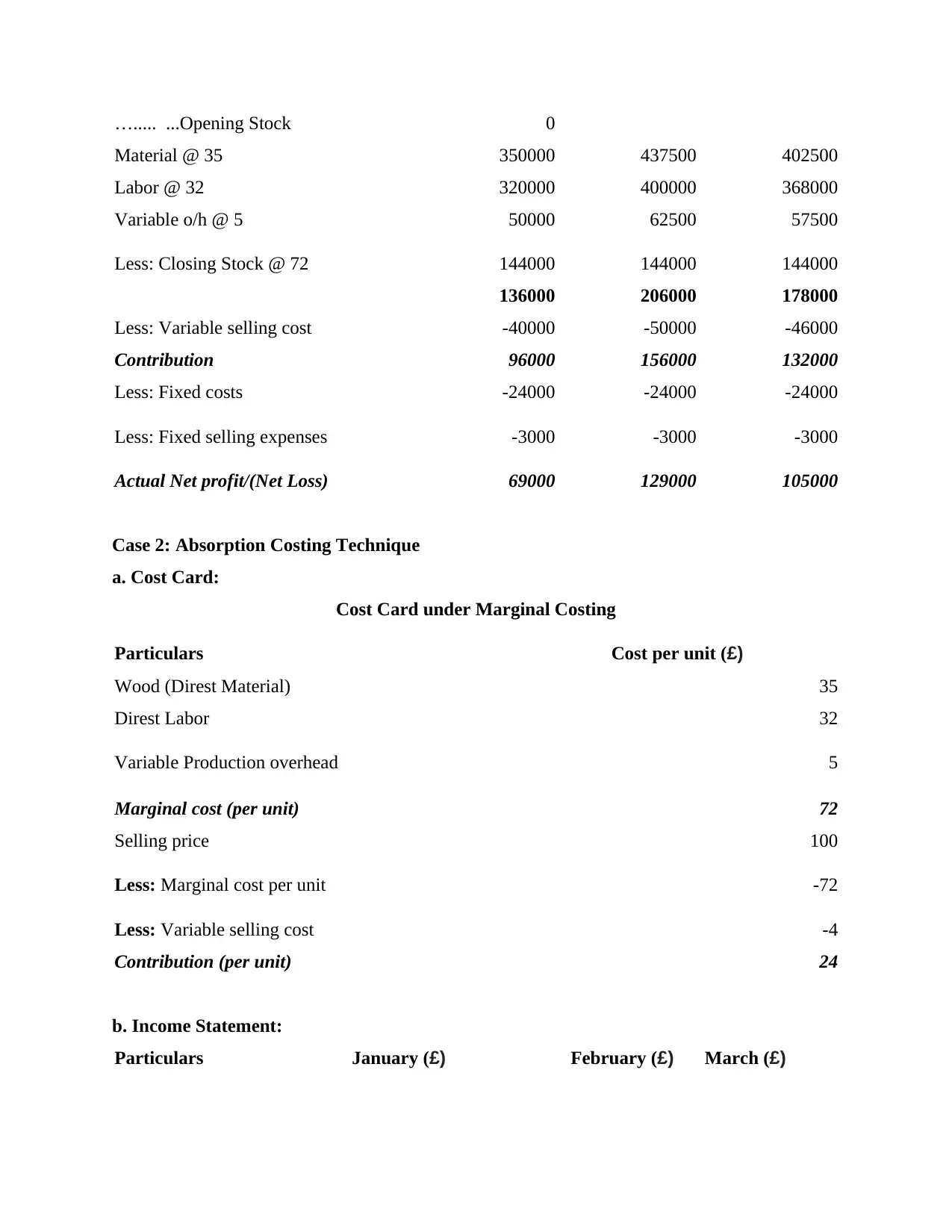
…..... ...Opening Stock 0
Material @ 35 350000 437500 402500
Labor @ 32 320000 400000 368000
Variable o/h @ 5 50000 62500 57500
Less: Closing Stock @ 72 144000 144000 144000
136000 206000 178000
Less: Variable selling cost -40000 -50000 -46000
Contribution 96000 156000 132000
Less: Fixed costs -24000 -24000 -24000
Less: Fixed selling expenses -3000 -3000 -3000
Actual Net profit/(Net Loss) 69000 129000 105000
Case 2: Absorption Costing Technique
a. Cost Card:
Cost Card under Marginal Costing
Particulars Cost per unit (£)
Wood (Direst Material) 35
Direst Labor 32
Variable Production overhead 5
Marginal cost (per unit) 72
Selling price 100
Less: Marginal cost per unit -72
Less: Variable selling cost -4
Contribution (per unit) 24
b. Income Statement:
Particulars January (£) February (£) March (£)
Material @ 35 350000 437500 402500
Labor @ 32 320000 400000 368000
Variable o/h @ 5 50000 62500 57500
Less: Closing Stock @ 72 144000 144000 144000
136000 206000 178000
Less: Variable selling cost -40000 -50000 -46000
Contribution 96000 156000 132000
Less: Fixed costs -24000 -24000 -24000
Less: Fixed selling expenses -3000 -3000 -3000
Actual Net profit/(Net Loss) 69000 129000 105000
Case 2: Absorption Costing Technique
a. Cost Card:
Cost Card under Marginal Costing
Particulars Cost per unit (£)
Wood (Direst Material) 35
Direst Labor 32
Variable Production overhead 5
Marginal cost (per unit) 72
Selling price 100
Less: Marginal cost per unit -72
Less: Variable selling cost -4
Contribution (per unit) 24
b. Income Statement:
Particulars January (£) February (£) March (£)
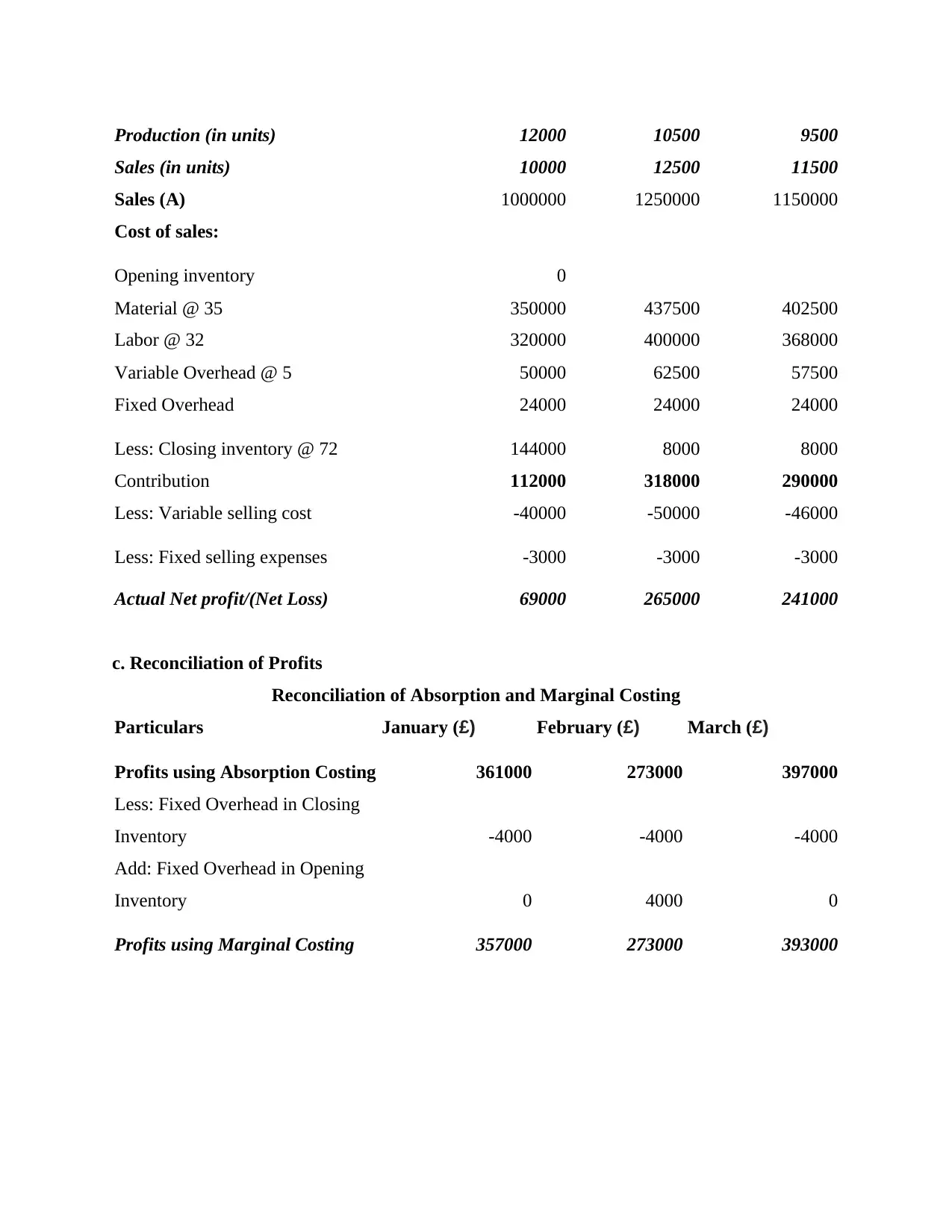
Production (in units) 12000 10500 9500
Sales (in units) 10000 12500 11500
Sales (A) 1000000 1250000 1150000
Cost of sales:
Opening inventory 0
Material @ 35 350000 437500 402500
Labor @ 32 320000 400000 368000
Variable Overhead @ 5 50000 62500 57500
Fixed Overhead 24000 24000 24000
Less: Closing inventory @ 72 144000 8000 8000
Contribution 112000 318000 290000
Less: Variable selling cost -40000 -50000 -46000
Less: Fixed selling expenses -3000 -3000 -3000
Actual Net profit/(Net Loss) 69000 265000 241000
c. Reconciliation of Profits
Reconciliation of Absorption and Marginal Costing
Particulars January (£) February (£) March (£)
Profits using Absorption Costing 361000 273000 397000
Less: Fixed Overhead in Closing
Inventory -4000 -4000 -4000
Add: Fixed Overhead in Opening
Inventory 0 4000 0
Profits using Marginal Costing 357000 273000 393000
Sales (in units) 10000 12500 11500
Sales (A) 1000000 1250000 1150000
Cost of sales:
Opening inventory 0
Material @ 35 350000 437500 402500
Labor @ 32 320000 400000 368000
Variable Overhead @ 5 50000 62500 57500
Fixed Overhead 24000 24000 24000
Less: Closing inventory @ 72 144000 8000 8000
Contribution 112000 318000 290000
Less: Variable selling cost -40000 -50000 -46000
Less: Fixed selling expenses -3000 -3000 -3000
Actual Net profit/(Net Loss) 69000 265000 241000
c. Reconciliation of Profits
Reconciliation of Absorption and Marginal Costing
Particulars January (£) February (£) March (£)
Profits using Absorption Costing 361000 273000 397000
Less: Fixed Overhead in Closing
Inventory -4000 -4000 -4000
Add: Fixed Overhead in Opening
Inventory 0 4000 0
Profits using Marginal Costing 357000 273000 393000
⊘ This is a preview!⊘
Do you want full access?
Subscribe today to unlock all pages.

Trusted by 1+ million students worldwide
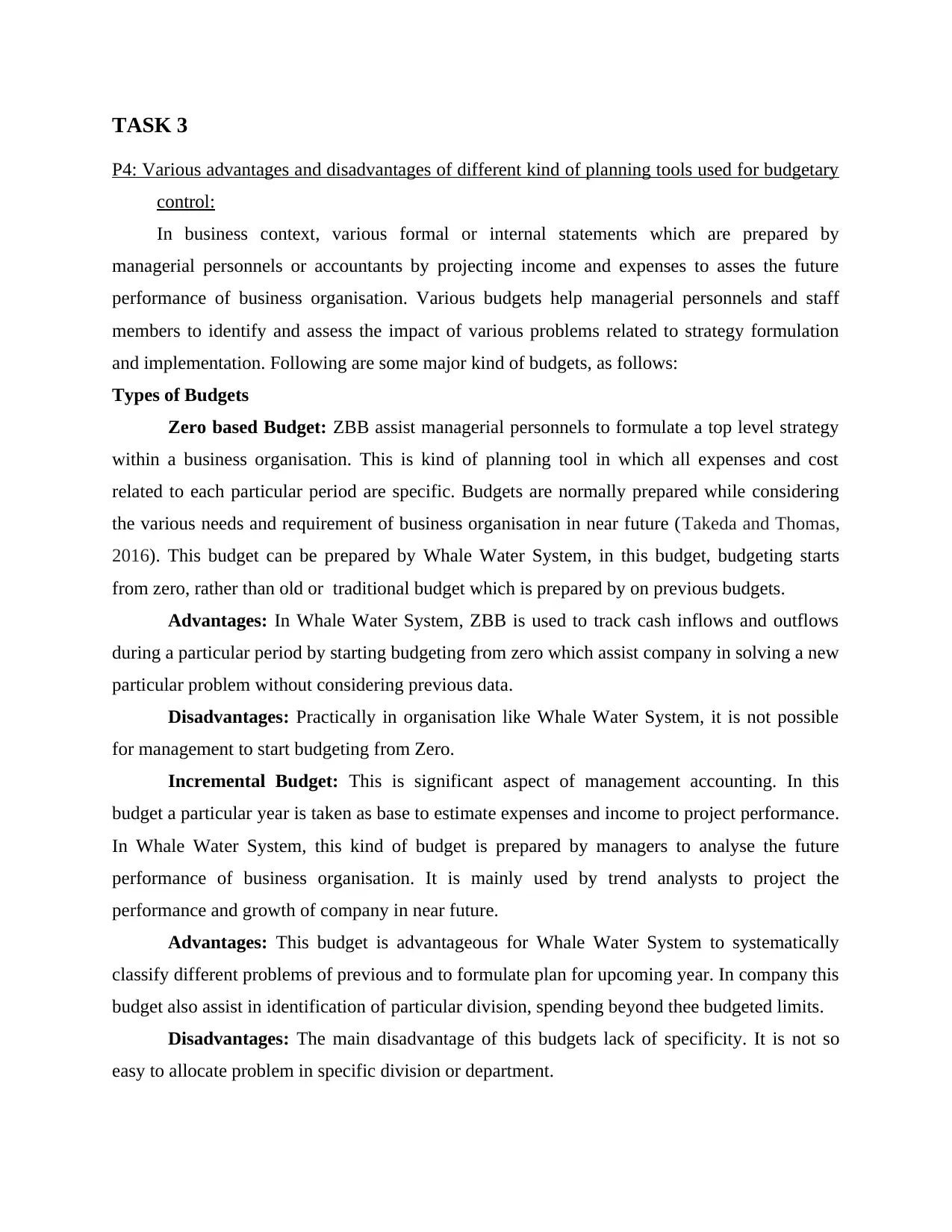
TASK 3
P4: Various advantages and disadvantages of different kind of planning tools used for budgetary
control:
In business context, various formal or internal statements which are prepared by
managerial personnels or accountants by projecting income and expenses to asses the future
performance of business organisation. Various budgets help managerial personnels and staff
members to identify and assess the impact of various problems related to strategy formulation
and implementation. Following are some major kind of budgets, as follows:
Types of Budgets
Zero based Budget: ZBB assist managerial personnels to formulate a top level strategy
within a business organisation. This is kind of planning tool in which all expenses and cost
related to each particular period are specific. Budgets are normally prepared while considering
the various needs and requirement of business organisation in near future (Takeda and Thomas,
2016). This budget can be prepared by Whale Water System, in this budget, budgeting starts
from zero, rather than old or traditional budget which is prepared by on previous budgets.
Advantages: In Whale Water System, ZBB is used to track cash inflows and outflows
during a particular period by starting budgeting from zero which assist company in solving a new
particular problem without considering previous data.
Disadvantages: Practically in organisation like Whale Water System, it is not possible
for management to start budgeting from Zero.
Incremental Budget: This is significant aspect of management accounting. In this
budget a particular year is taken as base to estimate expenses and income to project performance.
In Whale Water System, this kind of budget is prepared by managers to analyse the future
performance of business organisation. It is mainly used by trend analysts to project the
performance and growth of company in near future.
Advantages: This budget is advantageous for Whale Water System to systematically
classify different problems of previous and to formulate plan for upcoming year. In company this
budget also assist in identification of particular division, spending beyond thee budgeted limits.
Disadvantages: The main disadvantage of this budgets lack of specificity. It is not so
easy to allocate problem in specific division or department.
P4: Various advantages and disadvantages of different kind of planning tools used for budgetary
control:
In business context, various formal or internal statements which are prepared by
managerial personnels or accountants by projecting income and expenses to asses the future
performance of business organisation. Various budgets help managerial personnels and staff
members to identify and assess the impact of various problems related to strategy formulation
and implementation. Following are some major kind of budgets, as follows:
Types of Budgets
Zero based Budget: ZBB assist managerial personnels to formulate a top level strategy
within a business organisation. This is kind of planning tool in which all expenses and cost
related to each particular period are specific. Budgets are normally prepared while considering
the various needs and requirement of business organisation in near future (Takeda and Thomas,
2016). This budget can be prepared by Whale Water System, in this budget, budgeting starts
from zero, rather than old or traditional budget which is prepared by on previous budgets.
Advantages: In Whale Water System, ZBB is used to track cash inflows and outflows
during a particular period by starting budgeting from zero which assist company in solving a new
particular problem without considering previous data.
Disadvantages: Practically in organisation like Whale Water System, it is not possible
for management to start budgeting from Zero.
Incremental Budget: This is significant aspect of management accounting. In this
budget a particular year is taken as base to estimate expenses and income to project performance.
In Whale Water System, this kind of budget is prepared by managers to analyse the future
performance of business organisation. It is mainly used by trend analysts to project the
performance and growth of company in near future.
Advantages: This budget is advantageous for Whale Water System to systematically
classify different problems of previous and to formulate plan for upcoming year. In company this
budget also assist in identification of particular division, spending beyond thee budgeted limits.
Disadvantages: The main disadvantage of this budgets lack of specificity. It is not so
easy to allocate problem in specific division or department.
Paraphrase This Document
Need a fresh take? Get an instant paraphrase of this document with our AI Paraphraser
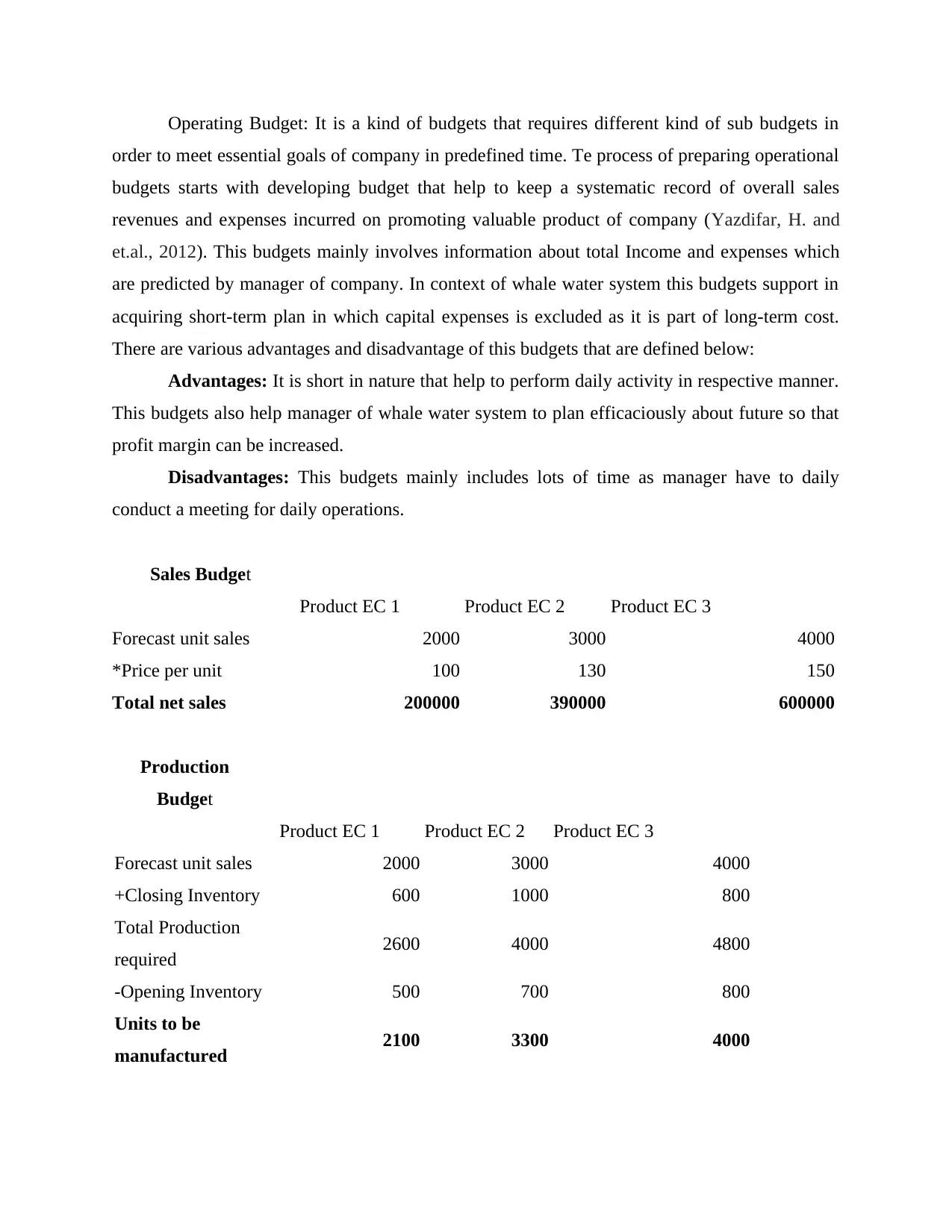
Operating Budget: It is a kind of budgets that requires different kind of sub budgets in
order to meet essential goals of company in predefined time. Te process of preparing operational
budgets starts with developing budget that help to keep a systematic record of overall sales
revenues and expenses incurred on promoting valuable product of company (Yazdifar, H. and
et.al., 2012). This budgets mainly involves information about total Income and expenses which
are predicted by manager of company. In context of whale water system this budgets support in
acquiring short-term plan in which capital expenses is excluded as it is part of long-term cost.
There are various advantages and disadvantage of this budgets that are defined below:
Advantages: It is short in nature that help to perform daily activity in respective manner.
This budgets also help manager of whale water system to plan efficaciously about future so that
profit margin can be increased.
Disadvantages: This budgets mainly includes lots of time as manager have to daily
conduct a meeting for daily operations.
Sales Budget
Product EC 1 Product EC 2 Product EC 3
Forecast unit sales 2000 3000 4000
*Price per unit 100 130 150
Total net sales 200000 390000 600000
Production
Budget
Product EC 1 Product EC 2 Product EC 3
Forecast unit sales 2000 3000 4000
+Closing Inventory 600 1000 800
Total Production
required 2600 4000 4800
-Opening Inventory 500 700 800
Units to be
manufactured 2100 3300 4000
order to meet essential goals of company in predefined time. Te process of preparing operational
budgets starts with developing budget that help to keep a systematic record of overall sales
revenues and expenses incurred on promoting valuable product of company (Yazdifar, H. and
et.al., 2012). This budgets mainly involves information about total Income and expenses which
are predicted by manager of company. In context of whale water system this budgets support in
acquiring short-term plan in which capital expenses is excluded as it is part of long-term cost.
There are various advantages and disadvantage of this budgets that are defined below:
Advantages: It is short in nature that help to perform daily activity in respective manner.
This budgets also help manager of whale water system to plan efficaciously about future so that
profit margin can be increased.
Disadvantages: This budgets mainly includes lots of time as manager have to daily
conduct a meeting for daily operations.
Sales Budget
Product EC 1 Product EC 2 Product EC 3
Forecast unit sales 2000 3000 4000
*Price per unit 100 130 150
Total net sales 200000 390000 600000
Production
Budget
Product EC 1 Product EC 2 Product EC 3
Forecast unit sales 2000 3000 4000
+Closing Inventory 600 1000 800
Total Production
required 2600 4000 4800
-Opening Inventory 500 700 800
Units to be
manufactured 2100 3300 4000
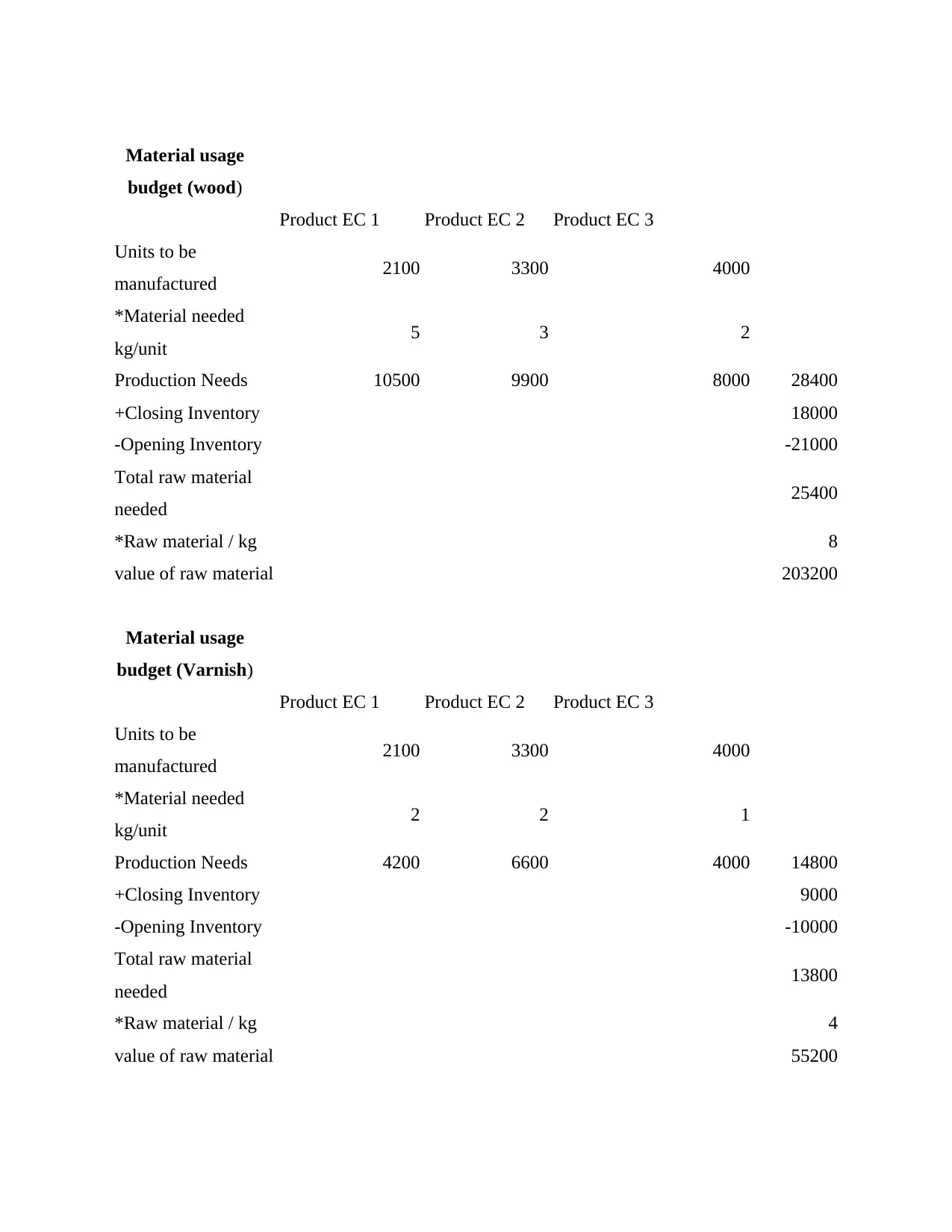
Material usage
budget (wood)
Product EC 1 Product EC 2 Product EC 3
Units to be
manufactured 2100 3300 4000
*Material needed
kg/unit 5 3 2
Production Needs 10500 9900 8000 28400
+Closing Inventory 18000
-Opening Inventory -21000
Total raw material
needed 25400
*Raw material / kg 8
value of raw material 203200
Material usage
budget (Varnish)
Product EC 1 Product EC 2 Product EC 3
Units to be
manufactured 2100 3300 4000
*Material needed
kg/unit 2 2 1
Production Needs 4200 6600 4000 14800
+Closing Inventory 9000
-Opening Inventory -10000
Total raw material
needed 13800
*Raw material / kg 4
value of raw material 55200
budget (wood)
Product EC 1 Product EC 2 Product EC 3
Units to be
manufactured 2100 3300 4000
*Material needed
kg/unit 5 3 2
Production Needs 10500 9900 8000 28400
+Closing Inventory 18000
-Opening Inventory -21000
Total raw material
needed 25400
*Raw material / kg 8
value of raw material 203200
Material usage
budget (Varnish)
Product EC 1 Product EC 2 Product EC 3
Units to be
manufactured 2100 3300 4000
*Material needed
kg/unit 2 2 1
Production Needs 4200 6600 4000 14800
+Closing Inventory 9000
-Opening Inventory -10000
Total raw material
needed 13800
*Raw material / kg 4
value of raw material 55200
⊘ This is a preview!⊘
Do you want full access?
Subscribe today to unlock all pages.

Trusted by 1+ million students worldwide
1 out of 18
Related Documents
Your All-in-One AI-Powered Toolkit for Academic Success.
+13062052269
info@desklib.com
Available 24*7 on WhatsApp / Email
![[object Object]](/_next/static/media/star-bottom.7253800d.svg)
Unlock your academic potential
Copyright © 2020–2025 A2Z Services. All Rights Reserved. Developed and managed by ZUCOL.





